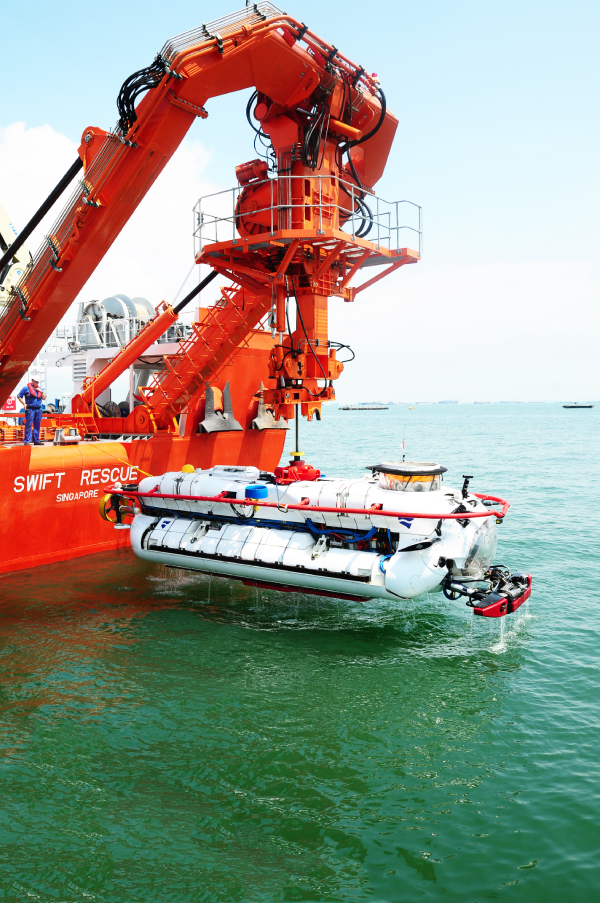
Submarine rescue vehicles (DSRVs) is the strongest, but not the least, capability on which JFD has built its reputation among naval and special forces.
The underwater world is the Earth’s least explored geographical area, primarily because it is so difficult for people to operate under the waves with ease and for long periods. The majority of naval submarines operate at depths below, often well below, 600 metres (2,000 feet). Some nuclear submarines have stronger hulls and have increased design depths that are mainly below 900m (3,000ft), but they are not the usual operational depths. The deepest area of the ocean, by contrast, is the Mariana Trench which has been measured at 11,034m (36,200 feet).
When a catastrophe happens onboard a military submarine, such as in the case of the Indonesian Navy’s Cakra-class Type 209/1300 diesel-electric attack submarines KRI Nanggala-402 in April 2021, the main concern is to locate it and try and rescue the crew in the shortest possible time. Unfortunately, when wreckage was discovered it was at a depth of of 850m (2,800 ft), way beyond its stated crush depth of around 500m (1,600 ft).
But on the scene was a submarine rescue vessel from James Fisher’s rescue company JFD, a specialist global supplier of submarine rescue vehicles. Should circumstances have been different and the submarine had been discovered intact with a crew needing rescue, the specialist deep sea rescue vehicle (DSRV) would have been deployed to try and rescue the crew.
International rescue
“Submarine rescue is the core of what we do,” said Richard Dellar, JFD’s managing director speaking to Asian Military Review. The company’s Submarine Rescue Service (SRS) has a reputation and a customer base to match. The Singaporean and Indian Navies are two of the stand-out customers. “We recently signed a 25 year support maintenance contract with the Indian Navy which began this year, said Dellar. The Indian Navy has fully embraced the capability, including having its own operators fully trained and able to operate the equipment independently. “India has done more live sub-mates – practising extracting crews out of submarines using the rescue vessel and into the hyperbaric chamber – in the three years that they have had the craft than some of our other customers who have had their kit for 20 years,” explained Dellar. He added that the Indian Navy had transitioned to maintaining and operating their own sub rescue systems.

This contrasts with the requirements of the Republic of Singapore Navy (RSN), where the direct and continuing involvement of JFD personnel is preferred. Although RSN deck officers retain command of each mission “everything else is crewed by us. We go to sea and operate the ship’s systems and processes, conduct the dive and pilot the rescue vehicles,” explained Dellar. “There aren’t that many contractors that get involved in operations,” he added.
Customers need to be aware of the logistics of deploying a DSRV. Originally transportable in the Antanov 225, now destroyed as a casualty of Russia’s invasion of the Ukraine, smaller military transport aircraft are used but they cannot carry the same load meaning more flights over a longer period of time. “There is about 400 tons of our kit that is air portable, so that requires seven or eight flights. The DSRVs weight about 25 tons, but then all the other vital elements such as the hyperbaric kit, the launch and recovery systems and the power generators are needed. We turn up and presume the ship we will deploy on has nothing, said Dellar. This comes down to the detail of having to weld the launch and recover frame to the deck of the rescue ship.
There is also a consideration in the actual geographical location where any rescue will be conducted. Rather than having one ship dedicated to supporting any rescue with the DSRV, which may be hundreds of miles from where it is needed when an incident occurs, an air portable kit would usually same time provided the large enough transport aircraft such as Boeing’s C-17 or Lockheed Martin C-130 Hercules can be called upon.
“Today, typical submarine crew is between 130-140 personnel. A typical rescue lift in the DSRV would be between 15 to a maximum of 20 people at one time – fewer if there are people with serious injuries to extract.more if some are injured. Two to three hours between mate, surface and ready to go again. We need to know what the customers mission is and then we can drive it from a modular perspective.
One of the problems facing naval operators is the training time that is required, especially for a DSRV pilot. “The training programme typically takes two and a half years, but often by the time someone has been fully trained they are close to being rotated out to their next assignment. Also they must have to have a certain amount of dive time before we can train them, hence the need for us to train as many people as possible,” said Dellar. But this is reliant on the customer’s budget and is the reason behind JFD’s efforts to establish an unofficial club of operators – so that each operator may be able to call on other national operators in a time of crisis – and all crews are trained to the same standard.
JFD has a history of service with the Royal Australian Navy (RAN) with a contract that ran for 15 years. The RAN’s DSRV is shortly coming up for either renewal or a major service and with the AUKUS (trilateral security pact between Australia, the United Kingdom and the United States) set to deliver Australia’s first fleet of nuclear powered attack submarines, any discussion about the requirements of a DSRV need to parallel the acquisition process.

Special Operations / Diver Delivery
JFD has a number of different capability areas other than the submarine rescue services, the other three being special operations; ‘black’ boats; and commercial systems. Alistair Wilson strategy, sales and marketing director at JFD explains that there is a growing desire to see a cross-over between ‘dry’ rescue vehicles which are not designed to be covert, and ‘wet’ diver delivery vehicles – the black boats. “We have our wet tactical diving submersibles but recent defence papers point to new options [now under discussion] for crossing the water gap.” He added that there is a growing demand for different solutions, particularly for the role of special operator delivery and the number of people that can be delivered by one platform.
Although the company has standardised on two delivery platforms – the two man Torpedo Seal and four man Shadow Seal – JFD is considering this opportunity for alternative solutions. It can also offer customers the eight-man Carrier Seal which can run on the surface and sub-surface, “We have other types of vehicle on our road map that will extend that existing family. There is more interest now in DSRV.”
Transporting special forces in a mobile platform that can operate autonomously without needing specialist back up support is increasingly being considered which will serve to drive the expand of the domain. “Just as there are options for surface and air delivery, so there is a growing desire for a suite of vehicles that you can pick from your [platform] toolbox for specific missions – and currently this is not very well served. We feel that the underwater domain market for moving things and people is evolving quickly,” said Wilson.
“We are also moving towards autonomised craft,” he added. “One of the UK requirements is an Unmanned Surface / Subsurface Vehicle (USSV). We have a mature manned platform so we are looking at the next stage – an autonomised platform – which can be manned or unmanned. He offers the scenario of special forces needing to be collected from a shoreline, where an unmanned autonomous vehicle can be sent to pick them up and then once onboard, the operators can take over manned control. “We are excited about that as a transition for us in that we have the experience of mature manned platforms already. We are investing in this now.,” said Wilson.
Diver support is also one of JFD’s strengths, from personal rebreather systems to masks, hyperbaric chambers. “We have a successful Joint Venture (JV) in Germany who are our single biggest customer, supplying the German Navy with their rebreathers.

Full speed ahead
Investing in new craft and technology is something that JFD is doing, and is eager to expand. Often the company, in talking to its existing and potential customers, helps them to develop their own concept of operations.
“The cross over between special operations requirements and commercial needs is enormous from a core technology perspective,” said Dellar. “It is all about life support systems. Irrespective of differing certification – one is always driving the other. Each one pushes different aspects which the other will also find useful.
In addressing the development of new craft, JFD faces the dilemma of wanting to expand its product line, but only in line with what its current and future customers are going to require. While keeping cost under control is central to the price of any new development, the scope of special operations in particular is just beginning to expand beyond those few forces that have already embraced the concept.
JFD is looking to break into the US military market, particularly with the Special Operations Command (SOCOM), and is trying to find the right US partner. “There are programmes of record where we would like to play a part and some where we would like to help shape the requirement,” said Dellar. There are potential opportunities in swimmer delivery vehicles and dry deck shelters, he added.
by Andrew Drwiega












